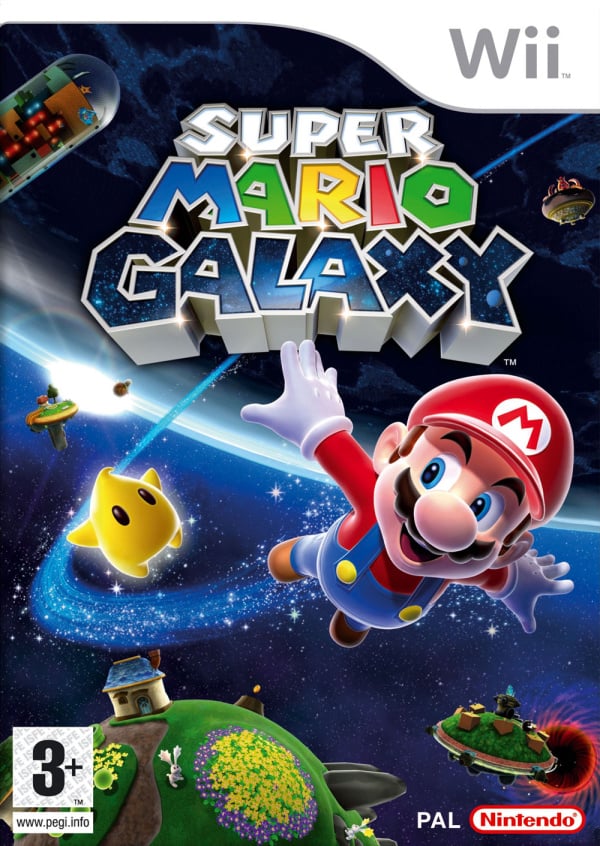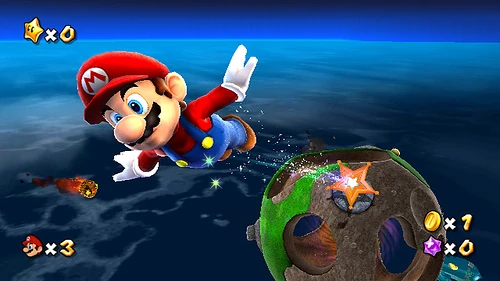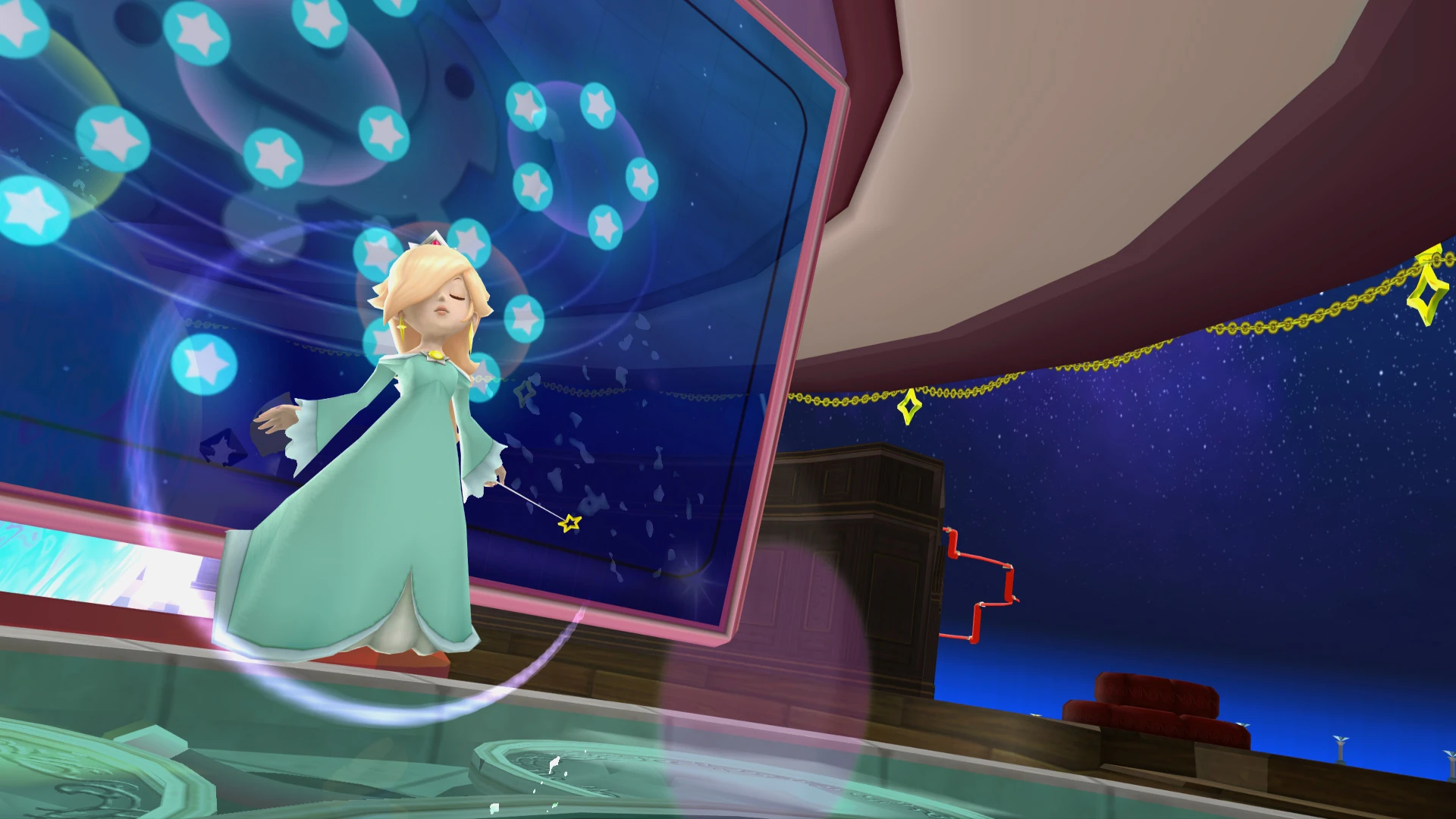 Released: November 12, 2007 (USA)
Released: November 12, 2007 (USA)
Platform: Nintendo Wii
Introduction
Super Mario Galaxy is a 3D platforming game released for the Wii in 2007. It followed the first two
3D Mario games, Super Mario 64 and Super Mario Sunshine, and compared to those games, the worlds in Super Mario Galaxy are more linear.
The game takes place in outer space, and the main gameplay quirk is the ability to walk around planets using new gravity effects. It also makes use of the Wii's motion controls, as Mario can only perform his spin move when the player shakes the Wii remote (at the time, Nintendo was really pushing the Wii's motion controls).
Also, just a heads up: this game is my favorite game of all time, and because of my many memories associated with this game, I can't promise I will be unbiased. Actually, you can count on me being biased, but bear with me, because I NEED to share why I think this game is so wonderful. Besides, this game is the highest rated game of all time on GameRankings, and the second highest on Metacritic, so I'm far from alone. Without further ado...
3D Mario games, Super Mario 64 and Super Mario Sunshine, and compared to those games, the worlds in Super Mario Galaxy are more linear.
The game takes place in outer space, and the main gameplay quirk is the ability to walk around planets using new gravity effects. It also makes use of the Wii's motion controls, as Mario can only perform his spin move when the player shakes the Wii remote (at the time, Nintendo was really pushing the Wii's motion controls).
Also, just a heads up: this game is my favorite game of all time, and because of my many memories associated with this game, I can't promise I will be unbiased. Actually, you can count on me being biased, but bear with me, because I NEED to share why I think this game is so wonderful. Besides, this game is the highest rated game of all time on GameRankings, and the second highest on Metacritic, so I'm far from alone. Without further ado...
Gameplay
As with most Mario games, Super Mario Galaxy is the king of gameplay. Mario travels through 42 galaxies, with multiple missions in most galaxies, to get a Power Star at the.
end. He uses a variety of jumps, many of which were in previous games, but what was novel in Super Mario Galaxy was the ability to walk all around the surfaces of the 3D planets, as can be seen below:
 There are some points in the game where the player is required to point at the screen. By pointing at the screen, the player can collect 'star bits', shoot them at enemies, and pull Mario from place to place using Pull Stars. Unlike the motion controls needed for the spin move, this actually felt a bit forced and unnecessary. Whenever it was required to point at the screen, I felt ripped away from the core gameplay.
There are some points in the game where the player is required to point at the screen. By pointing at the screen, the player can collect 'star bits', shoot them at enemies, and pull Mario from place to place using Pull Stars. Unlike the motion controls needed for the spin move, this actually felt a bit forced and unnecessary. Whenever it was required to point at the screen, I felt ripped away from the core gameplay.
end. He uses a variety of jumps, many of which were in previous games, but what was novel in Super Mario Galaxy was the ability to walk all around the surfaces of the 3D planets, as can be seen below:
Mario has a new move, called the Star Spin, which makes him do a spin when the player shakes the Wii Remote (this was part of Nintendo's push to get motion controls in every single game). But even with the weird controls, the move feels natural, and for me it helped set the game apart from previous Mario games because of all the new moves and mechanics it offered. The spin move is used to screw in giant screws, deflect flying coconuts back at a boss, launch in a launch star from planet to planet, and to extend Mario's jump in midair. This move and the new gravitational mechanics are really what makes up the 'meat' of Super Mario Galaxy.
 There are some points in the game where the player is required to point at the screen. By pointing at the screen, the player can collect 'star bits', shoot them at enemies, and pull Mario from place to place using Pull Stars. Unlike the motion controls needed for the spin move, this actually felt a bit forced and unnecessary. Whenever it was required to point at the screen, I felt ripped away from the core gameplay.
There are some points in the game where the player is required to point at the screen. By pointing at the screen, the player can collect 'star bits', shoot them at enemies, and pull Mario from place to place using Pull Stars. Unlike the motion controls needed for the spin move, this actually felt a bit forced and unnecessary. Whenever it was required to point at the screen, I felt ripped away from the core gameplay.Music
 The score to Super Mario Galaxy was almost entirely recorded by a full symphony orchestra. It was the first Nintendo game to do so, and they did it perfectly. The sweeping soundtrack really fits the atmosphere of outer space, and I think the score is movie-quality. One song, "Gusty Garden Galaxy", is probably the most well-known Mario song today aside from the songs from the first game, and for good reason:
The score to Super Mario Galaxy was almost entirely recorded by a full symphony orchestra. It was the first Nintendo game to do so, and they did it perfectly. The sweeping soundtrack really fits the atmosphere of outer space, and I think the score is movie-quality. One song, "Gusty Garden Galaxy", is probably the most well-known Mario song today aside from the songs from the first game, and for good reason:Not all the music is orchestral, however, as the game also boasts some great electronic-style synth music, especially in galaxies based around artificial structures. Many songs also combine the recorded orchestra music with electronic instruments to create some really interesting music, such as with "Buoy Base Galaxy":
The song starts out with some electronic arpeggios switching between two chords, and then shifts into an orchestral melody for a short while. It switches back and forth a few times, until it reaches a point where the electronic background plays while the sweeping orchestral melody sits on top. Songs like this really fill out the grandiose atmosphere of space.
There are also some musical touches to the game that might not be noticed by the average player. There are certain sound effects in the game that change depending on the music being played. This includes the harp glissando that plays when Mario uses a launch star, and the sound effect that plays when a coin pops out of something. In this game, depending on the chord currently being played in the song, the sound effect will change keys in order to be in harmony with the music at its current spot. Because these sound effects change as the music plays, it almost sounds like they're a part of the music, which really adds to the game's epic atmosphere.
Art/Visuals
 |
| Green grass against the dark blue background |
Mario Galaxy's visuals are striking for a number of reasons, and one I really noticed is the use of bright, contrasting colors against each other. There are a great many galaxies where the background "sky" (outer space) is a deep blue, which contrasts with the bright green grass of the planets.
There are also many other uses of beautiful color contrast, such as the deep red magma meeting the surrounding blue-green aurora of the background in the Freezeflame Galaxy.
Super Mario Galaxy hasn't aged perfectly, as it was released on the Wii, which can only output at 480p. While some games are uninhibited by a low resolution, Galaxy doesn't fare the best nowadays, especially on larger screens.
But different aspects of the game make it seem to look better, regardless of the resolution. Everything in the game feels like it has a soft edge, which is not affected by the resolution and gives the game a unifying visual style. Overall though, I feel like the amazing soundtrack picks up the slack of the slightly outdated visuals this game has today.
Story/Characters
 |
| Rosalina on her spaceship, the Comet Observatory |
Rosalina calls herself the "Mother of the Stars", and acts as a mother to the many star-shaped creatures known as Lumas. Very little is revealed about her initially, but her backstory can be revealed through an optional storybook on the Comet Observatory. Rosalina's Storybook is laid out like a children's book, with simple and elegant language that describes the heartwarming and emotional story of her youth.
The illustrations are also beautifully simplistic, and unlike anything seen before in a Mario game.
My favorite part of the story was Chapter 7: The Telescope. In the previous chapters, the whole story was about Rosalina searching the cosmos for her mother, who was supposedly coming for her on a comet. In this chapter, however, that search quickly comes to an end, as the music changes, and a memory resurfaces:
I remember when I read the Storybook for the first time, and my eyes welled up as I read that. The perfect combination of the music shift, the beautiful art, and the eloquent storytelling clicked for me.
The illustrations are also beautifully simplistic, and unlike anything seen before in a Mario game.
My favorite part of the story was Chapter 7: The Telescope. In the previous chapters, the whole story was about Rosalina searching the cosmos for her mother, who was supposedly coming for her on a comet. In this chapter, however, that search quickly comes to an end, as the music changes, and a memory resurfaces:
She twisted the knob of the telescope, and the blue dot grew until she could make out a grassy hill dotted with flowers. It seemed very familiar to her. Zooming even closer, a terrace on the hill came into view. "I used to go stargazing there when I lived on my home planet."
She remembered rubbing the sleep out of her eyes as she followed her father up that hill to look at the stars...
She remembered how she and her brother would sled down that hill...
She remembered having picnics with her mother on that hill on bright and windy days... And...
"I want to go home! I want to go home right now!" The girl burst into tears, and the Lumas didn't know what to do. "I want to go home! I want to go back to my house by the hill! I want to see my mother!" The girl was shouting now, her face wet with tears. "But I know she's not there! I knew all along that she wasn't out there in the sky! Because...because..."
"She's sleeping under the tree on the hill!" The girl's cries echoed through the stars, and a hush fell over the area.
I remember when I read the Storybook for the first time, and my eyes welled up as I read that. The perfect combination of the music shift, the beautiful art, and the eloquent storytelling clicked for me.
Impact/Context
Super Mario Galaxy was released to near universal critical acclaim back in 2007. Even when it was released, untouched by nostalgia, fans and critics alike knew it was something special. The Nintendo Wii, the fifth-best selling video game console of all time, sold 101 million units, and 1 out of every 4 Wii owners owned Super Mario Galaxy. This means there are more people who will have fond childhood memories of Galaxy than its predecessors, Super Mario 64 and Super Mario Sunshine.
Speaking of those games, Super Mario Galaxy marked a shift in direction for the 3D Mario series. While 64 and Sunshine featured more open, non-linear worlds, Galaxy's missions were much more linear, with the player being limited to certain parts of each galaxy for different missions. Because Super Mario Galaxy was so amazing, fans of the 3D Mario series had few objections to the shift, but as the following 3D Mario games became more linear, they began to object. (Responding to those objections, the newest 3D Mario game returns to the style of the first games)
Notes
YAY! My favorite game! Next up is Bayonetta 2, which should be interesting. I'm probably going to have a whole section about Controversy for that game, so stay tuned.





No comments:
Post a Comment